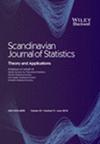Deep neural network classifier for multidimensional functional data
IF 1
4区 数学
Q3 STATISTICS & PROBABILITY
引用次数: 4
Abstract
Abstract We propose a new approach, called as functional deep neural network (FDNN), for classifying multidimensional functional data. Specifically, a deep neural network is trained based on the principal components of the training data which shall be used to predict the class label of a future data function. Unlike the popular functional discriminant analysis approaches which only work for one‐dimensional functional data, the proposed FDNN approach applies to general non‐Gaussian multidimensional functional data. Moreover, when the log density ratio possesses a locally connected functional modular structure, we show that FDNN achieves minimax optimality. The superiority of our approach is demonstrated through both simulated and real‐world datasets.多维函数数据的深度神经网络分类器
摘要:本文提出了一种新的方法,称为功能深度神经网络(FDNN),用于多维功能数据的分类。具体来说,深度神经网络是基于训练数据的主成分来训练的,这些主成分将被用来预测未来数据函数的类标签。与仅适用于一维泛函数据的流行泛函判别分析方法不同,本文提出的FDNN方法适用于一般的非高斯多维泛函数据。此外,当对数密度比具有局部连接的功能模块结构时,我们证明了FDNN实现了极小极大最优性。通过模拟和真实世界的数据集证明了我们方法的优越性。
本文章由计算机程序翻译,如有差异,请以英文原文为准。
求助全文
约1分钟内获得全文
求助全文
来源期刊

Scandinavian Journal of Statistics
数学-统计学与概率论
CiteScore
1.80
自引率
0.00%
发文量
61
审稿时长
6-12 weeks
期刊介绍:
The Scandinavian Journal of Statistics is internationally recognised as one of the leading statistical journals in the world. It was founded in 1974 by four Scandinavian statistical societies. Today more than eighty per cent of the manuscripts are submitted from outside Scandinavia.
It is an international journal devoted to reporting significant and innovative original contributions to statistical methodology, both theory and applications.
The journal specializes in statistical modelling showing particular appreciation of the underlying substantive research problems.
The emergence of specialized methods for analysing longitudinal and spatial data is just one example of an area of important methodological development in which the Scandinavian Journal of Statistics has a particular niche.
 求助内容:
求助内容: 应助结果提醒方式:
应助结果提醒方式:


